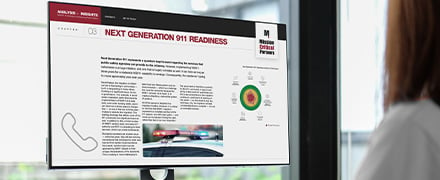Apple Announces a Promising Step Toward Solving 911's Wireless Location Challenges
Posted on January 26, 2018 by John Chiaramonte
Sensational headlines criticizing the 911 industry’s inability to accurately and quickly locate emergency callers abound, like this recent one in the Wall Street Journal: “Why Uber Can Find You but 911 Can’t.” This is one of the industry’s most intractable issues—as TV host John Oliver said in 2016, “There doesn’t appear to be a simple, satisfying answer,” to why smartphone apps provide much better location information than that received by 911 centers.
Those within the industry understand the problem: 80 percent or more of all 911 calls are made using a wireless device, and such calls are routed based on Phase I data, which is the location of the cellular tower. More accurate “Phase II” data can become available (usually) in 25-35 seconds of the call being received by the 911 center, but that depends on multiple factors, including signal strength/distortion, geography and topology, especially when calls are made inside structures.
But, smartphones are supposed to be “smart” and the device knows where the caller is physically located, because of embedded GPS sensors and Wi-Fi positioning systems. Unfortunately, as we know all too well, today’s 911 systems do not have access to that device-generated location information.
911’s Location Issue Solved?
Interestingly, thanks to John Medland and Ian Johnston and their colleagues at British Telecom (BT), a simple and elegant solution called Advanced Mobile Location, or AML, was developed in 2014 to better locate callers using the United Kingdom’s (U.K.’s) 999 emergency system. The European Emergency Number Association (EENA) announced in 2016 that BT’s partnership with Google, support for AML was implemented in all Android operating systems worldwide.
Apple announced yesterday that its future release of iOS 11.3 will include support for AML in Apple devices. With more than 98 percent of all smartphones running either Android or iOS operating systems, 911 officials should be ecstatic that accurate location information via AML is coming to a 911 center near them soon. Unfortunately, while Apple’s announcement is exciting, it’s just not enough to have AML within the handset’s OS.
Carriers must act quickly to enable AML for 911 calling in the U.S.
AML is a great solution that will fundamentally improve the ability of 911 centers to locate emergency callers; however, it’s only currently activated in eight countries: Austria, Belgium, Estonia, Finland, Iceland, Ireland, Lithuania, and New Zealand, as well as the U.K. So, while the technology exists on your Android device (and soon on Apple devices), it isn’t enabled in the U.S. and none of the domestic wireless carriers have announced a timeline for adding this lifesaving technology.
This situation must change and time is of the essence. Without AML enabled, telecommunicators in 911 centers across the U.S. will continue to struggle to locate emergency callers. While additional regulatory action from the Federal Communications Commission (FCC) seems unlikely anytime soon, the only other option available is to encourage the carriers to act voluntarily to implement this technology. Assuming just one of the four largest wireless carriers implements AML, the others would follow, right? What carrier wants to be criticized for failing to protect its subscribers by not implementing software that already resides on their phones, but isn’t activated?
As online petitions seem unlikely to make a difference, here’s a simple plea to Verizon, AT&T, T-Mobile, and Sprint: Which of you wants to be seen as a progressive champion, serving the critical needs of the 911 sector and all those who call 911 in their time of greatest need? Please do the right thing and turn on AML— now. The millions of people who call 911 each year are depending on you to help 911 find them more quickly, which in turn will save more lives—when it comes to 911, every second counts.







